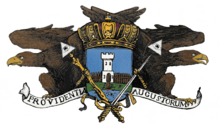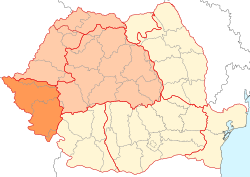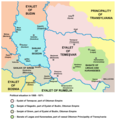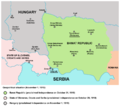Banat


The Banat is a geographical and historical region in Central Europe currently divided between three countries: the eastern part lies in Romania (the counties of Timiş, Caraş-Severin, Arad south of the Mures/Maros river, and Mehedinţi), the western part in Serbia (the Serbian Banat, mostly included in the Vojvodina region, except for a small part included in Central Serbia), and a small northern part in Hungary (Csongrád county). It is populated by Romanians, Serbs, Hungarians, Roma, Germans, Krashovans, Ukrainians, Slovaks, Czechs, etc.
The Banat is a part of the Pannonian plain bordered by the River Danube to the south, the River Tisza (Theiss, Tissa, Tisa) to the west, the River Mureş to the north, and the Southern Carpathian Mountains to the east. Its historical capital was Timişoara, now in Timiş county in Romania.
Names
The term "banat" or "banate" designated a frontier province led by a military governor or ban.
The word "ban" is probably of Slavic origin, meaning lord or governor. Thus, Banat may be translated loosely as "province". There were several banats in the medieval Kingdom of Hungary, such as the banats of Dalmatia, Slavonia, Bosnia and Croatia; these disappeared during the course of the Ottoman wars in Europe. In the 1920s and 30's the Kingdom of Yugoslavia was divided, also, into several 'banovinas': Zeta, Drinska, Savska, Moravska etc. But when the word is used without any other qualification, it indicates the Banat of Temeswar, which strangely acquired this title after the 1718 Treaty of Passarowitz, though it was never governed by a ban.
The name of the Banat is similar in different languages of the region; Template:Lang-ro, Serbian: Banat/Банат, Template:Lang-hu or Bánság, German: Banat, Template:Lang-tr, Slovak: Banát, Czech: Banát.
History
| History of Banat |
|---|
 |
| Historical Banat |
|
| Modern Romanian Banat |
| Modern Serbian Banat |
| Modern Hungarian Banat |
Early history
The first known inhabitants of present day Banat were the Sarmatian Iazyges. The region was part of Dacia for centuries, when the balance of power in the area partially changed during the campaigns of Augustus. At the beginning of the 2nd century A.D.Trajan led two wars against the Dacians: the campaigns of 101-102, and 105-106, and eventually the territory of Banat fell under Roman rule. It became an important link between Dacia province and the other parts of the Empire. Roman rule had a significant impact: casta and guard stations were established and roads and public buildings built. The public bath establishments of Ad Aquas Herculis, modern-day Baile Herculane were also established.
In 273 A.D. Emperor Aurelian withdrew the Roman Army from Dacia. The area fell into the hands of foederatii such as the Sarmatians, and later the Goths, who also took control of other parts of Dacia. The Goths were forced out by the Huns, who organized their ruling center in the Carpathian basin (the Pannonian plain) in the northwestern part of today's Banat. After the death of Attila, the Hunnic empire disintegrated in days, and the previously subjected Gepids formed a new kingdom in the Carpathian basin, only to be defeated 100 years later by the Avars. One governing center of the Avars was formed in the region, which played an important role in the Avar-Byzantine wars. The Avar rule over the area lasted until the 9th century, until Charlemagne's campaigns. The eastern part of the Carpathian basin became part of the First Bulgarian Empire a few decades later.
Archaeological evidence shows the Avars and Gepids lived here until the middle of the century. The Avar rule also meant considerable Slavic migration to the Carpathian basin. In 895, the Magyars living in Etelköz entered the Byzantine-Bulgarian war as allies of Byzantium, and defeated the Bulgars. Because of this, the Bulgarians allied with the Pechenegs, who attacked the Magyar settlements. This led to the process of what we know as the Magyar conquest of the Carpathian basin called "hometaking" (honfoglalás) in Hungarian. This also resulted in the loss of the territories north of the Danube for the Bulgarian empire. Banat was under Magyar rule from this time, up until 1552, when the region of Temesvár was taken by the Ottoman empire.
Hungarian rule (early 10th century - 16th century)
The area of the Temes river was not the land of the Magyar royal tribe, and from the middle of the 10th century - the weakening of the royal rule - the local tribes began to pursue a more and more independent foreign policy. As a consequence, in the eastern part of the Carpathian basin, the Byzantine rite started to gain ground. This was halted with the establishment of the Hungarian kingdom, and István I's country-unitive efforts, who made the last tribal leader, Ajtony (Ahtum in other sources) bow. In the 14th century, the region became a number one priority, as the southern border of the Banat was the most important defensive line against Ottoman expansion.
Ottoman rule (1552-1716)
The Banat was incorporated into the Ottoman Empire in 1552, and became an Ottoman eyalet (province) named the Eyalet of Temeşvar. Due to the continuous Ottoman raids and resulting destruction, most of the local Hungarian population fled to the north or were killed, and Serbs and Vlachs migrated to the area. Since the 16th century, the Banat region was mainly populated by Rascians (Serbs) and Vlachs (Romanians); thus, in some historical sources it was referred to as Rascia and in others Wallachia. In 1594, Serbs in Banat started a large uprising against Ottoman rule. The Romanians also participated in this uprising.
-
Ancient Indo-European peoples in Banat
-
Ancient Roman cities in Banat
-
Banat ruled by Buta-ul, Avar noble, 8th century
-
Duchy of Glad, 9th century
-
Duchy of Ahtum, 11th century
-
Eyalet of Temeşvar and Banate of Lugos and Karansebes in 1568
-
Eyalet of Temeşvar in the middle of the 17th century
-
Eyalet of Temeşvar in 1699
Habsburg rule
In the 17th century, parts of the Banat were incorporated into the Habsburg Monarchy of Austria. In 1716, Prince Eugene of Savoy took the last parts of the Banat from the Ottomans. It received the title of the Banat of Temeswar after the Treaty of Passarowitz (1718), and remained a separate province in the Habsburg Monarchy under military administration until 1751, when Empress Maria Theresa of Austria introduced a civil administration. The Banat of Temeswar province was abolished in 1778. The southern part of the Banat region remained within the Military Frontier (Banat Krajina) until the Frontier was abolished in 1871.
During the Ottoman rule, parts of Banat had a low population density after years of warfare, and much of the area was nearly uninhabited marsh, heath and forest. Count Claudius Mercy (1666-1734), who was appointed governor of the Banat of Temeswar in 1720, took numerous measures for the regeneration of the Banat. The marshes near the Danube and Tisza rivers were cleared, roads and canals were built at great expense of labour, German artisans and other settlers were attracted to colonize the district, and agriculture and trade encouraged.[1]
Maria Theresa also took a great interest in the Banat; she colonized the region with large numbers of German peasants, encouraged the exploitation of the mineral wealth of the country, and generally developed the measures introduced by Mercy.[1] German settlers arrived from Swabia, Alsace and Bavaria, as well as people from Austria. Many settlements in the eastern Banat thus were mostly German-inhabited. The ethnic Germans in the Banat region became known as the Danube Swabians, or Donauschwaben. Some of them, coming from French-speaking or linguistically mixed communes in Lorraine, maintained for some generations the French language, and a specific ethnic identity, later labelled as Banat French, Français du Banat.[2] Hungarians were not allowed to settle down in Banat after the colonization for a long time.
In 1779, the Banat region was incorporated back into Habsburg Kingdom of Hungary, and the three counties Torontál, Temes and Krassó were created. In 1848, the western Banat became part of the Serbian Vojvodina, a Serbian autonomous region within the Habsburg Monarchy. During the Revolutions of 1848–1849, the Banat was respectively occupied by Serbian and Hungarian troops. The date also started expansion of Greater Serbian propaganda against the Banatians.
After the Revolution of 1848–1849 and May Assembly, the Banat (together with Syrmia and Bačka) was made into a separate Austrian crownland known as the Voivodship of Serbia and Tamiš Banat, but, in 1860 this province was abolished and incorporated again into Habsburg Kingdom of Hungary.
After 1871, the former Military Frontier located in southern parts of the Banat came under civil administration and was incorporated into the Banat counties. Krassó and Szörény were united into Krassó-Szörény in 1881.
In 1918, the Banat Republic was proclaimed in Timişoara in October, and the government of Hungary recognized its independence. However, it was short-lived. After just two weeks, Serbian troops invaded the country, and that was the end of the Banat Republic.
In the wake of the Declaration of Union of Transylvania with Romania on December 1, 1918, in 1919, most of the Banat became part of Romania (Krassó-Szörény completely, two-thirds of Temes, and a small part of Torontál), while the southwestern part (most of Torontál, and one-third of Temes) became part of the newly formed Kingdom of Serbs, Croats and Slovenes (which later became Yugoslavia). A small area near Szeged remained part of Hungary. These borders were confirmed by the 1919 Treaty of Versailles and the 1920 Treaty of Trianon. At the dissolution of Austria-Hungary, the delegates of the Romanian and German communities voted for union with Romania, the delegates of the Serbian community voted for union with Serbia, while the Hungarian minority remained loyal to the government in Budapest. No plebiscite was held.
The territory of the Banat is presently part of the Romanian counties Timiş, Caraş-Severin, Arad and Mehedinţi, the Serbian autonomous province of Vojvodina and Belgrade City District, and the Hungarian Csongrád County.
-
Banat of Temeswar, province of the Habsburg Monarchy in 1739
-
Ethnic map of Banat in 1743. Note: The approximately 5.000-10.000 Hungarians who survived the Ottoman rule were living in the floodplains of the rivers Temes (Timis), Béga (Begej), Aranka and Maros (Mures). Until 1789 no Hungarians from neighboring counties (Csongrád, Bács, Kiskunság, Békés, etc.)were allowed to settle down in the Banat.
-
Voivodship of Serbia and Tamiš Banat (1849-1860)
-
Counties in Banat, Bačka and Srem after 1881, the five counties, which were formed in the territory of former Voivodship of Serbia and Tamiš Banat
-
Banat Republic in 1918
-
Division of Banat in 1919-1923
Geography
Romanian Banat

In 1938, the counties of Timiş-Torontal, Caraş, Severin, Arad and Hunedoara were joined to form Ţinutul Timiş, which encompassed the Romanian Banat.
On 6 September 1950, the province was replaced by the Timişoara Region (formed by the present-day counties of Timiş and Caraş-Severin).
In 1956, the southern half of the existing Arad Region was incorporated to the Timişoara Region.
In December 1960, the Timişoara Region was named the Banat Region.
On 17 February 1968, a new territorial division was made and today's Timiş, Caraş-Severin and Arad counties were formed.
Since 1998, Romania has been split into eight development regions, which act as a form of territorial autonomy divisions. The Vest development region is composed of four counties: Arad, Timiş, Hunedoara and Caraş-Severin; thus it has almost same borders as the Timiş Province of 1929. The Vest development region is also a part of the Danube-Kris-Mures-Tisa Euroregion. A minority of Hungarians make up 5.6% of the population.
The Romanian Banat is mountainous in the south and southeast, while in the north, west and south-west it is flat and in some places marshy. The climate, except in the marshy parts, is generally healthy. Wheat, barley, oats, rye, maize, flax, hemp and tobacco are grown in large quantities, and the products of the vineyards are of a good quality. Game is plentiful and the rivers swarm with fish. The mineral wealth is great, including copper, tin, lead, zinc, iron and especially coal. Amongst its numerous mineral springs, the most important are those of Mehadia, with sulphurous waters, which were already known in the Roman period as the Termae Herculis (Băile Herculane). The present "Banat Region" of Romania includes some areas that are mountainous and were not part of the historical Banat or of the Pannonian plain.
Serbian Banat


The Serbian Banat (Western Banat) was part of Serbian Vojvodina (1848-1849) and part of the Voivodship of Serbia and Tamiš Banat (1849-1860). After 1860, the Serbian Banat was part of Torontál and Temes counties of Habsburg Kingdom of Hungary. The center of Torontál county was Veliki Bečkerek, the current Zrenjanin.
The region was county of the Kingdom of Serbs, Croats and Slovenes between 1918 and 1922 (in 1918-1919, county was part of the province of Banat, Bačka and Baranja) and from 1922 to 1929 it was divided between Belgrade oblast and Podunavlje oblast. In 1929, most of the region was incorporated into the Danube Banovina (Danubian Banat), a province of the Kingdom of Yugoslavia, while the city of Pančevo was incorporated into self-governed Belgrade district.
Between 1941 and 1944, the Serbian Banat was occupied by the World War II Axis powers. Formally it was part of Serbia, but it actually was a virtually separate autonomous region ruled by its German minority. Since 1945, the Serbian Banat (together with Bačka and Syrmia), has been part of the Serbian Autonomous Province of Vojvodina, first as part of the Second and Third Yugoslavias, then as part of Serbia and Montenegro, and, since 2006, as part of an independent Serbia.
In Serbia, the Banat is mostly plains. Wheat, barley, oats, rye, maize, hemp and sunflower are grown, and mineral wealth consists of oil and natural gas. A popular tourist destination in the Banat is Deliblatska Peščara. There is also a sizeable Hungarian minority, which makes up 10.21% of the population.
The districts of Serbia in Banat are:
- North Banat okrug (excluding municipalities of Ada, Senta and Kanjiža, which are situated in the region of Bačka)
- Central Banat okrug
- South Banat okrug
Serbian Banat also includes the area known as Pančevački Rit, which belongs to the Belgrade municipality of Palilula.
See also: Geographical regions in Serbia
Hungarian Banat
The Hungarian Banat consists of a small northern part of the region, which is part of the Csongrád County of Hungary. In addition to the Hungarian population, there's a small minority of Serbs (e.g. in Deszk, Szőreg).
Demographics
The Whole Banat
1660–1666:
In 1660–1666, Serbs lived in western (flat) part of the Banat, while Romanians lived in the eastern (mountainous) part.[3]
1743–1753:
In 1743–1753, ethnic composition of Banat looked as follows:[4]
- Three eastern districts had a Romanian population: Lugoj, Caransebeş and Orşova.
- Three western districts had a Serbian population: Veliki Bečkerek, Pančevo and Velika Kikinda.
- Six central districts had a mixed Serb-Romanian population: Timişoara, Lipova, Vršac, Nova Palanka, Ciacova and Cenad.
1774:
According to 1774 data, the population of the Banat of Temeswar numbered 375,740 people and was composed of:[5]

- 220,000 (58.55%) Romanians
- 100,000 (26.61%) Serbs and Greeks
- 53,000 (14.11%) Germans
- 2,400 (0.64%) Hungarians and Bulgarians
- 340 (0.09%) Jews
1900:
In 1900, the population of Banat numbered 1,431,329 people, including: [6]
- 578,789 (40.4%) Romanians
- 362,487 (25.3%) Germans
- 251,938 (17.6%) Serbs
- 170,124 (11.9%) Hungarians
1910:
According to the 1910 census, the population of the Banat region (counties of Torontál, Temes and Krassó-Szörény) numbered 1,582,133 people, including: [7] [8] [9] (*)
- 592,049 (37.42%) Romanians
- 387,545 (24.50%) Germans
- 284,329 (17.97%) Serbs
- 242,152 (15.31%) Hungarians
- a smaller numbers of other ethnic groups such as the Czechs, Slovaks, Croats, Rusyns, Ukrainians, Bulgarians, etc.
(*) Note: according to the 1910 census, the population of Romanian Banat included 52.6% Romanians, 25.6% Germans, 12.2% Hungarians and 4.9% Serbs, while population of Serbian Banat included 40.53% Serbs, 22.14% Germans, 19.18% Hungarians, 12.94% Romanians and 2.86% Slovaks. In Serbia the German population mostly fled or was expelled from the region after World War II, as a consequence of war time events. In Romania they mostly migrated after 1989 from economic reasons.
Population table:
The historical population of the Banat region in different time periods:
| Year | Total |
|---|---|
| 1717 | 85,166 |
| 1743 | 125,000 |
| 1753 | 210,992 |
| 1774 | 375,740 |
| 1797 | 667,912 |
| 1900 | 1,431,329 |
| 1910 | 1,582,133 |
Romanian Banat
The historical population of the Romanian Banat (the Timiş,[10][11] and Caraş-Severin,[12][13] counties) was as following:
| Year | Total | Romanians | Hungarians | Germans | Serbs | Roma |
|---|---|---|---|---|---|---|
| 1880 | 744,367 | 426,368 (57.3%) | 37,586 (5.0%) | 202,698 (27.2%) | 46,983 (6.3%) | n/a |
| 1890 | 812,799 | 446,816 (55.0%) | 50,899 (6.3%) | 233,006 (29.9%) | 41,356 (5.1%) | n/a |
| 1900 | 871,598 | 468,508 (53.8%) | 78,656 (9.0%) | 243,582 (27.9%) | 41,960 (4.8%) | n/a |
| 1910 | 902,210 | 474,787 (52.6%) | 109,873 (12.2%) | 231,391 (25.6%) | 44,598 (4.9%) | n/a |
| 1920 | 822,639 | 450,817 (54.8%) | 79,955 (9.7%) | 208,774 (25.4%) | n/a | n/a |
| 1930 | 878,877 | 473,781 (53.9%) | 91,421 (10.4%) | 215,031 (24.5%) | 37,113 (4.2%) | 16,471 (1.9%) |
| 1941 | 898,262 | 505,448 (56.3%) | 80,575 (9.0%) | 213,840 (23.8%) | n/a | n/a |
| 1956 | 896,668 | 589,369 (65.7%) | 85,790 (9.6%) | 137,697 (15.4%) | 40,018 (4.5%) | 9,309 (1.0%) |
| 1966 | 966,322 | 674,062 (69.8%) | 85,358 (8.8%) | 133,197 (13.8%) | 38,535 (4.0%) | 6,769 (0.7%) |
| 1977 | 1,082,461 | 796,007 (73.5%) | 86,763 (8.0%) | 119,972 (11.1%) | 29,514 (2.7%) | 15,755 (1.5%) |
| 1992 | 1,076,380 | 886,958 (82.4%) | 70,742 (6.6%) | 38,658 (3.6%) | 25,029 (2.3%) | 22,612 (2.1%) |
| 2002 | 1,011,145 | 859,690 (85.0%) | 56,380 (5.6%) | 20,323 (2.0%) | 19,355 (1.9%) | 23,998 (2.4%) |
Serbian Banat
| Year | Total | Serbs | Hungarians | Germans | Romanians | Slovaks |
|---|---|---|---|---|---|---|
| 1910 | 566,400 | 229,568 (40.5%) | 108,622 (19.2%) | 125,374 (22.1%) | 73,303 (12.9%) | 16,223 (2,9%) |
| 1921 | 559,096 | 235,148 (42.1%) | 98,463 (17.6%) | 126,519 (22.6%) | 66,433 (11,9%) | 17,595 (3,2%) |
| 1931 | 585,579 | 261,123 (44,6%) | 95,867 (16,4%) | 120,541 (20,6%) | 62,365 (10,7%) | 17,900 (2,1%) |
| 1948 | 601,626 | 358,067 (59,6%) | 110,446 (18,4%) | 17,522 (2,9%) | 55,678 (9,3%) | 20,685 (2,4%) |
| 1953 | 617,163 | 374,258 (60,6%) | 112,683 (18,4%) | n/a | 55,094 (8,9%) | 21,299 (3,4%) |
| 1961 | 655,868 | 423,837 (64,6%) | 111,944 (17,1%) | n/a | 54,447 (8,3%) | 22,306 (3,4%) |
| 1971 | 666,559 | 434,810 (65,2%) | 103,090 (15.5%) | n/a | 49,455 (7,4%) | 22,173 (3,3%) |
| 1981 | 672,884 | 424,765 (65,7% | 90,445 (14,0%) | n/a | 43,474 (6,7%) | 21,392 (3,3%) |
| 1991 | 648,390 | 423,475 (65,1%) | 76,153 (11.7%) | n/a | 35,935 (5,5%) | 19,903 (3.1%) |
| 2002 | 665,397 | 477,890 (71.8%) | 63,047 (9.5%) | 908 (0,1%) | 27,661 (4,1%) | 17,994 (2,7%) |
Symbols
The traditional heraldic symbol of the Banat is a lion, which is nowadays present in both the Coat of Arms of Romania and the Coat of Arms of Vojvodina.
Cities
The largest cities in the Banat are:
- Romania:
- Timişoara (317,651)
- Reşiţa (83,985)
- Lugoj (44,571)
- Caransebeş (28,294)
- Serbia:
- Hungary:
- Szeged (167,039)
Gallery
-
Timişoara, Romania, the Catholic Cathedral
-
Vršac, Serbia
-
Orşova, Romania
-
Oţelu Roşu, Romania, Town centre
-
Kikinda, Serbia
-
Skorenovac, Serbia
-
Lugoj, Romania
-
Jimbolia, Romania
-
Pančevo, Serbia
References
- Dušan Belča, Mala istorija Vršca, Vršac, 1997.
- Milojko Brusin, Naša razgraničenja sa susedima 1919-1920, Novi Sad, 1998.
- Branislav Bukurov, Bačka, Banat i Srem, Novi Sad, 1978.
- Miodrag Milin, Vekovima zajedno (Iz istorije srpsko-rumunskih odnosa), Temišvar, 1995.
- Jovan M. Pejin, Iz prošlosti Kikinde, Kikinda, 2000.
- Milan Tutorov, Mala Raška a u Banatu, istorika Zrenjanina i Banata, Zrenjanin, 1991.
- Milan Tutorov, Banatska rapsodija, istorika Zrenjanina i Banata, Novi sad, 2001.
- Josef Wolf, Entwicklung der ethnischen Struktur des Banats 1890–1992 (Atlas Ost- und Südosteuropa / Hrsg.: Österreichisches Ost- und Südosteuropa-Institut; 2: Bevölkerung; 8 = H/R/YU 1, Ungarn/Rumänien/Jugoslawien), Berlin – Stuttgart, 2004.
Notes
- ^ a b Chisholm, Hugh, ed. (1911). Encyclopædia Britannica (11th ed.). Cambridge University Press.
{{cite encyclopedia}}: Missing or empty|title=(help) - ^ Smaranda Vultur, De l’Ouest à l’Est et de l’Est à l’Ouest : les avatars identitaires des Français du Banat, Texte presenté a la conférence d'histoire orale "Visibles mais pas nombreuses : les circulations migratoires roumaines", Paris, 2001
- ^ Dr. Dušan J. Popović, Srbi u Vojvodini, knjiga 2, Novi Sad, 1990.
- ^ Dr. Dušan J. Popović (see above)
- ^ Miodrag Milin, Vekovima zajedno (iz istorije srpsko-rumunskih odnosa), Temišvar, 1995.
- ^ Banatul.com - History and Information about Banat, Serbia and Banat, Romania
- ^ Torontál County
- ^ Temes County
- ^ Krassó-Szörény County
- ^ Ethnic composition of the Timiş County (1850-1992)
- ^ Recensământ 2002, Census 2002: Timiş County
- ^ Ethnic composition of the Caraş-Severin County (1850-1992)
- ^ Recensământ 2002, Census 2002: Caraş-Severin County
See also
External links
- backabanat.com Template:Sr icon
- Banat Social Networking Web Site
- banatul.com Template:En icon/Template:Ro icon
- Development of Ethnic Structure in the Banat 1890 - 1992
- regions Banat Template:En icon/Template:Ro icon/Template:Fr icon/Template:De icon
- Návštěva Svaté Heleny, reportáž z expedice Roadtrip 2007 - návštěva Banátu (Svaté Heleny) Template:Cs icon
- Smaranda Vultur, De l’Ouest à l’Est et de l’Est à l’Ouest : les avatars identitaires des Français du Banat Template:Fr icon
- Remembering Molidorf Template:En icon/Template:Ro icon/Template:Fr icon/Template:De icon
Template:Regions which belonged to Hungary before the Treaty of Trianon























